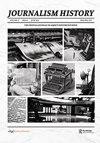“A Praying Woman”: The Press Framing of Telephone Supervisor Lisa Jefferson and Her Conversation with United 93 Passenger Todd Beamer
Q4 Social Sciences
引用次数: 0
Abstract
On September 11, 2001, a GTE Airfone supervisor took a call from United Flight 93 passenger Todd Beamer, who said the airplane had been highjacked. Supervisor Lisa Jefferson, a Black woman, stayed on the line with Beamer for thirteen minutes, until just before Beamer and his fellow passengers staged an attempted revolt and the plane crashed in a field just outside of Shanksville, Pennsylvania. The goal of this essay is to identify how the press framed Jefferson and her phone call with Beamer on September 11, 2001. After a newspaper database search, the analysis includes the following publications: the (Chicago) Daily Herald, the Chicago Tribune, and the (Tinley Park, Illinois) Sunday Star (as Jefferson was a Chicago native); the Somerset Daily American (serving Shanksville); the Pittsburgh Post-Gazette (seventyfive miles from Shanksville); the (New Brunswick) Central New Jersey Home News (serving Beamer’s home); the Washington Post (which provided extensive coverage of 9/11); and the (Fort Lauderdale) South Florida Sun-Sentinel (which carried articles from a correspondent covering 9/11). The examination involves articles, headlines, and photos published in September 2001 through the end of the year and those published on the one-year and every five-year anniversary through 2016. This analysis uses framing theory to reveal one significant news frame: the “praying woman,” a Black woman of quiet strength whose religious faith helps her endure in a time of crisis. This frame is noteworthy, as it draws on and adds to the research that has recorded the use of news frames to depict Black women in stereotypical ways.“一个祈祷的女人”:电话主管丽莎·杰斐逊的新闻框架及其与93号联合航空乘客托德·比默的对话
2001年9月11日,GTE Airfone的一名主管接到了联合航空93号航班乘客Todd Beamer的电话,他说飞机被劫持了。主管丽莎·杰斐逊是一名黑人女性,她与比默保持了13分钟的联系,直到比默和他的乘客们发动了一场未遂的反抗,飞机坠毁在宾夕法尼亚州尚克斯维尔郊外的一块空地上。这篇文章的目的是确定媒体是如何陷害杰斐逊以及她在2001年9月11日与比默的电话的。在报纸数据库搜索后,分析包括以下出版物:(芝加哥)《每日先驱报》、《芝加哥论坛报》和(伊利诺伊州廷利公园)《星期日星报》(杰斐逊是芝加哥本地人);《萨默塞特每日美国人报》(为尚克斯维尔服务);《匹兹堡邮报》(距离尚克斯维尔七十五英里);(新不伦瑞克)新泽西州中部家庭新闻(为比默的家服务);《华盛顿邮报》(对9/11事件进行了广泛报道);以及(劳德代尔堡)《南佛罗里达太阳哨兵报》(刊登了一位报道9/11的记者的文章)。考试包括2001年9月至年底发表的文章、头条新闻和照片,以及2016年一周年和每五周年发表的文章和照片。这项分析使用框架理论揭示了一个重要的新闻框架:“祈祷的女人”,一个安静力量的黑人女性,她的宗教信仰帮助她在危机时刻忍受。这一框架值得注意,因为它借鉴并补充了记录使用新闻框架以刻板印象方式描绘黑人女性的研究。
本文章由计算机程序翻译,如有差异,请以英文原文为准。
求助全文
约1分钟内获得全文
求助全文

 求助内容:
求助内容: 应助结果提醒方式:
应助结果提醒方式:


